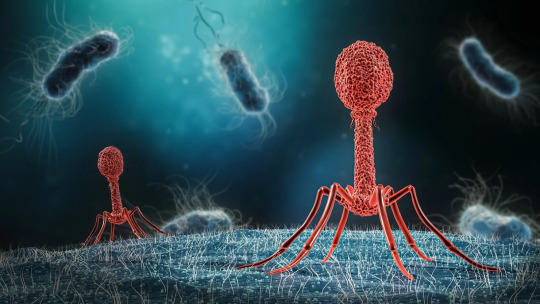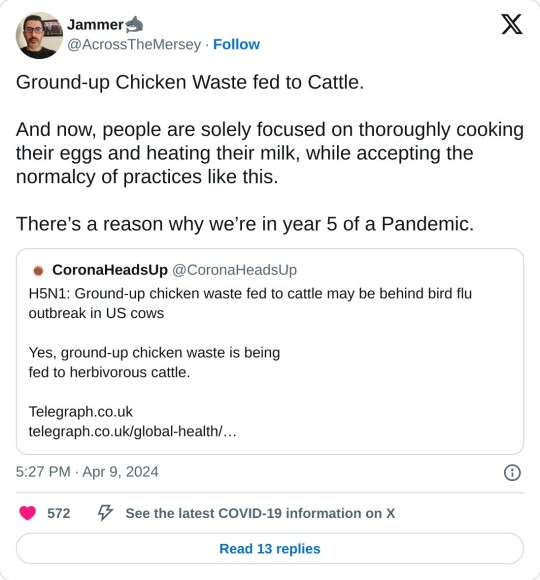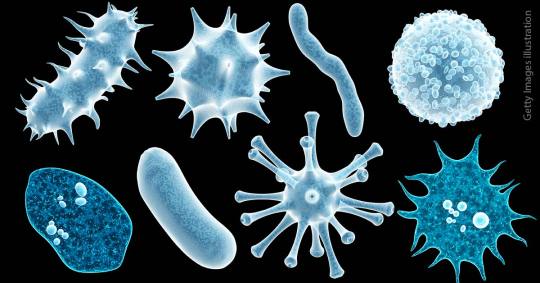#virology
Note
saw in your bio you’re researching infectious reptile diseases—that sounds cool as hell! which diseases specifically?
My research is in herpesviruses! I can’t give you the exact species I’m studying, but my interest is in how herpes viruses have been evolving alongside reptiles as well as mammals for millions of years.
Even among some very crafty pathogens, herpes stands out as the single most cunning family of viruses in the world (imo at least). They can evade immune systems, control populations, and basically bend ecosystems to their will. All without having the presence of mind to “intend” to do any of that. Herpes viruses are insanely interesting
53 notes
·
View notes
Text
A type of flu virus that used to sicken people every year hasn't been spotted anywhere on Earth since March 2020. As such, experts have advised that the apparently extinct viruses be removed from next year's flu vaccines.
The now-extinct viruses were a branch of the influenza B family tree known as the Yamagata lineage. Scientists first reported the apparent disappearance of Yamagata viruses in 2021. At that time, experts speculated that precautions taken to stop the spread of COVID-19 — such as masking and social distancing — had not only driven the overall number of flu cases to historic lows but may have completely snuffed out this type of flu virus.
Continue Reading.
20K notes
·
View notes
Note
What does "eclipse phase" mean in your description of the slug-eating JRPG? Does it describe some sort of a "until game over" hidden timer?
(With reference to this post here.)
"Eclipse phase" is a term used by some virologists to describe the period after a living cell has been infected by a virus, but before the cell exhibits any behavioural changes. Some of the sneakier viruses are notable for their exceptionally long eclipse phases, whereby an infected cell may continue to perform its normal function for months or years before suddenly switching to viral replication mode in response to some environmental trigger.
421 notes
·
View notes
Text
New Deep Ocean Virus Discovered

Life on Earth can be found even in the harshest of environments. But wherever there is life, you can find regulators of that life- and by that, I mean viruses. A group of researchers at the Ocean University of China have isolated a new virus from sediment collected from the Mariana Trench, some 8,900 meters below sea level. This is the deepest discovered virus ever.
The virus in question is a bacteriophage- one that infects and replicates inside bacteria. Bacteriophages are thought to be the most abundant life forms on the planet (that is, if you even consider them to be alive. But that’s for a whole other post). This bacteriophage infects bacteria in the phylum Halomonas, which can be found in deep sea sediments or in hydrothermal vents (Fun fact: one member of this phylum, Halomonas titanicae, was isolated from the ruins of the titanic, and helps to decompose materials such as shipwrecks on the seafloor).

When the researchers analyzed this new bacteriophage, they realized that it is part of an entirely unknown viral family that has been lurking in the depths of the ocean. Now, they will investigate the molecular machinery that defines interactions between deep sea viruses and their hosts, as well as continuing to look for new viruses in the most extreme of environments.
#science#stem#stemblr#science side of tumblr#biology#medicine#virology#marine virology#oceans#mariana trench#marine biology
346 notes
·
View notes
Text
#virus#virology#the great debate#microbiology#biology#life#philosophy#poll#tumblr polls#my polls#hw lb#gillianthecat goes back to school
250 notes
·
View notes
Text
Welcome to me trying to convince myself to revise for my exams by inserting my lecture material into six of crows quotes
Kaz leaned back. “What’s the easiest way to determine a gene’s function?”
“Knock it out?” asked Inej.
“Modify it?” said Jesper.
“Molecular tools?” suggested Nina.
“You’re all horrible,” said Matthias.
Kaz rolled his eyes. “The easiest way to discover a gene’s function is infect it with a virus. You change its behaviour and you can compare it to what it used to do. The Rous virus is going to do that job for us,”
#new au unlocked?#Kaz The overdramatic biomed student?#grishaverse#six of crows#leigh bardugo#crooked kingdom#inej ghafa#kaz brekker#nina zenik#jesper fahey#wylan van eck#matthias helvar#kanej#wesper#helnik#biomedicine#biology#biomedical science#biomed student#virology#virus#au#revision#six of crows au
346 notes
·
View notes
Text


"Experts warn that lax regulations could also see the virus spread to US pig farms, with serious consequences for human health."
"Fears are growing that the H5N1 outbreak among cattle in the United States could have been caused by contaminated animal feed."
"In contrast to Britain and Europe, American farmers are still allowed to feed cattle and other farm animals ground-up waste from other animals including birds."
"Dairy cows across six US states – and at least one farm worker – have become infected with the highly pathogenic virus, which has already killed millions of animals across the globe since 2021."
"Experts are unsure but fear it could be the poultry litter feed used in the US that has passed the virus to cattle."
“In the US, the feeding of poultry litter to beef cows is a known factor in the cause of botulism in cattle, and is a risk in the case of H5N1,” said Dr Steve Van Winden, Associate Professor in Population Medicine at the Royal Veterinary College."
"Dr Tom Peacock, a virologist and fellow at the Pirbright Institute agreed: “This latest case wouldn’t be the first time there have been concerns H5N1 could be moving through different mammals via contaminated feed,” citing the outbreak of avian flu in cats in Poland last year, which experts suspected might have been transmitted through mink byproducts used in raw cat food."
"At present, the WHO has said the risk to humans is considered low, but that surveillance efforts must be kept up."
#current events#current news#global news#cows#bird flu#avian flu#h5n1#pandemic#virus#healthcare#mask up#wear a mask#virology#united states#bird flu outbreaks#world news
59 notes
·
View notes
Text
Hot take: virology is the quantum mechanics of biology
We don't know exactly what is happening or why and how it's happening but we sure know stuff is happening
356 notes
·
View notes
Text



two things really stand out to me whenever i read about viruses...
we literally just assume covid leaves our bodies for.... no reason. like there's no specific reasons for this assumption, we just assume it because... it's convenient? all evidence points to the contrary, and this article is literally about how common it is for viruses to stay in your body forever.
these latent viruses don't just go dormant because they're playing nice. they're actively kept suppressed by the immune system. what happens if your immune system gets worn down by covid? that's why we're seeing so much reactivated EBV/mono, TB, strep... because we can't actually get these things out of us.
viruses are super interesting. they've played a mysterious but undeniably significant role in the development of living organisms. parts of us are literally made up of bits and pieces of virus. but the more you know about them, the more it's like... hey... why are we doing things this way again?
anyway. i really wish we had better antivirals for covid. but unfortunately, there's no scenario where having good treatments can be better than just avoiding catching it.
35 notes
·
View notes
Text
No one had ever seen one virus latching onto another virus, until anomalous sequencing results sent a UMBC team down a rabbit hole leading to a first-of-its-kind discovery.
It's known that some viruses, called satellites, depend not only on their host organism to complete their life cycle, but also on another virus, known as a "helper," explains Ivan Erill, professor of biological sciences. The satellite virus needs the helper either to build its capsid, a protective shell that encloses the virus's genetic material, or to help it replicate its DNA.
These viral relationships require the satellite and the helper to be in proximity to each other at least temporarily, but there were no known cases of a satellite actually attaching itself to a helper—until now.
Continue Reading.
181 notes
·
View notes
Text
Meet the TikTokker who's going viral by incorporating himself into your nuclear DNA.
709 notes
·
View notes
Text
People can say whatever they want, this vaccine has saved countless lives and it's one of the biggest advances in medicine lately. RNA vaccines are already showing great results against some cancers, and it all started there.
Plus one more woman for a science Nobel prize💪
68 notes
·
View notes
Link
Imagine possessing the power to foresee the appearance of hazardous viral strains well in advance of their impact. The scientists at Scripps Research in the USA invented an ML algorithm that employs spatial covariance, built upon Gaussian process (GP) principles, to monitor how genetic changes influence host-pathogen balance in biological contexts. Utilizing GP-based SCV (Spatial CoVariance) facilitates the association between variations in the SARS-CoV-2 genome and pathological manifestations. Utilizing GP-based SCV relationships and conducting genome-wide co-occurrence analysis create an early warning anomaly detection (EWAD) system for Variants of Concern (VOCs). EWAD can anticipate changes in the pattern of spread and pathology weeks or months ahead, identifying potential VOCs. Furthermore, GP-based SCV showcases a starting point to understand nature’s evolutionary path to complexity through natural selection. It carries significance beyond just the COVID-19 outbreak, stretching across different areas of human health to show how genetic variation impacts conditions like cancer and neurodegeneration.
A global pandemic quickly emerged due to the SARS-CoV-2 virus, causing the coronavirus disease 2019 (COVID-19). Over 600 million individuals have been impacted, and approximately 6 million deaths are expected as a consequence. Notably, the majority of severe cases and fatalities were observed in individuals aged 60 and above. The appearance of troubling variants such as Alpha, Delta, and Omicron exacerbated the already significant worldwide social and economic disruption.
For scientists to grasp the behavior of the virus and its increased fatality in older adults, experts underline the significance of investigating its entire genetic blueprint, called whole genome architecture (WGA) and analyzing its changes based on global genetic variability and physiological reactions from the host. Developing effective strategies to combat the virus and protect vulnerable populations relies on this crucial research.
Continue Reading
61 notes
·
View notes
Text
What are Viruses?

With cold and flu (and COVID) season upon us, people are sure to be talking a lot more about viruses. But what are viruses, exactly? They make us sick, but how does it work? Are they living organisms like bacteria? And how do vaccines prevent them? Skip to the end for a tl;dr, but I’m going to take these questions one at a time.
What is a virus?
Simply put- viruses are tiny particles that can infect a host cell in order to replicate themselves. Viruses are not made out of cells. They are much, much smaller than a cell- this diagram compares 3 different viruses to a red blood cell, an E. Coli bacterium, and a lysosome, which is an organelle that can be found within cells.

Viruses are fairly simple particles. Though they can be very diverse in structure, they share the same few basic features. The base “shell” of a virus is called the capsid, and is made out of protein units called capsomers. Inside this shell is the genome. This can consist of DNA, like our own genome, or strictly RNA. It contains instructions for replicating the virus. Some viruses also have envelopes, a membrane that surrounds the entire capsid, but this is not a universal feature.
Notably, viruses do not contain any sort of organelles, such as ribosomes. Ribosomes are what a cell uses to build the proteins that it needs to grow and replicate. So viruses contain the instructions on how to replicate, but they don’t have the machinery to do so. That is where the host cell comes in.
How do viruses infect us?
A virus’s singular goal is to replicate- to make copies of itself. But, as I discussed, they need access to ribosomes in order to build their protein capsids. Since they don’t have ribosomes of their own, a virus will enter a host cell and hijack its ribosomes, turning the cell into sort of a virus-producing factory.

Sometimes, a virus may simply inject its genetic material into a cell, rather than entering the cell entirely. If a virus has an envelope, the envelope can merge with the host cell’s membrane in order to let the virus inside. When the newly created viruses are leaving, they will steal a patch of membrane to use as their own envelopes and “bud off”. Otherwise, (at least in the case of human and animal viruses), the virus copies will build up inside the cell and keep replicating and replicating until the cell bursts open and they can escape. Kind of a creepy imagery if you think about it.
Are viruses alive?
…not really? Kind of? Viruses exist in a sort of gray area between alive and not alive. There are some criteria that scientists look at to determine if something is alive or not. One is that it can maintain homeostasis- the ability to control its temperature or internal contents. The general consensus is that viruses are not able to do that. Another criteria is that living things have different levels of organization- cells organize to form tissues to form organs and so on. Viruses do have that sort of organization, like the protein subunits that come together to form the capsid. Viruses can adapt to their environment, but they don’t grow. There is some debate if viruses can be said to reproduce. They certainly replicate, but since they can’t do so without commandeering a host cell it doesn’t really count. Finally, living things use energy. While a virus by itself doesn’t use energy, it will use the host cell’s energy in order to replicate. So to summarize, most biologists do not consider viruses to be alive, since they do not meet all of these criteria. There is some debate, though. Some biologists consider viruses to be alive, or alive when interacting with a host cell and not otherwise.
How do vaccines work?
Your body is not completely helpless against viruses. Your immune system has cells called B-cells and T-cells whose job is to kill any foreign substance, or any cells that have been hijacked by viruses. A vaccine basically shows these cells a dead or weak version of the virus so that when the real thing happens, they know what to look for and can respond much more quickly. You’re basically training them to fight the virus better.
To prevent the length of this post from getting out of hand I’m going to end it here, but if you want to know more you should check out Khan Academy’s series on viruses. It is presented in a very clear and easy to understand sort of way, and it is very informative.
https://www.khanacademy.org/science/biology/biology-of-viruses/virus-biology/a/intro-to-viruses
Tl;dr: Viruses are little protein bubbles filled with genetic information, and they hijack your cells to turn them into virus producing machines. Though there is some debate, most biologists don’t consider viruses to be alive. Vaccines help your immune cells recognize the signs of a viral infection so that they can respond quickly and keep you from becoming sick.
36 notes
·
View notes
Text

Nothing makes me feel so much like an alien as reading virology textbooks
120 notes
·
View notes
Text

› I don't think of myself as a king. No, I am a god! And even kings bow to gods!
9 notes
·
View notes